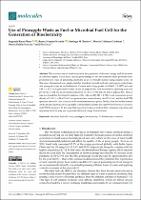Use of Pineapple Waste as Fuel in Microbial Fuel Cell for the Generation of Bioelectricity

View/
Author(s)
Rojas-Flores, Segundo
Nazario-Naveda, Renny
Benites, Santiago M.
Gallozzo-Cardenas, Moisés
Delfín-Narciso, Daniel
Díaz, Félix
Date
2022Metadata
Show full item recordPublisher
MDPI
Journal
Molecules 2022
Abstract
The excessive use of fossil sources for the generation of electrical energy and the increase in different organic wastes have caused great damage to the environment; these problems have promoted new ways of generating electricity in an eco-friendly manner using organic waste. In this sense, this research uses single-chamber microbial fuel cells with zinc and copper as electrodes and pineapple waste as fuel (substrate). Current and voltage peaks of 4.95667 ± 0.54775 mA and 0.99 ± 0.03 V were generated on days 16 and 20, respectively, with the substrate operating at an acid pH of 5.21 ± 0.18 and an electrical conductivity of 145.16 ± 9.86 mS/cm at two degrees Brix. Thus, it was also found that the internal resistance of the cells was 865.845 ± 4.726 Ω, and a maximum power density of 513.99 ± 6.54 mW/m2 was generated at a current density of 6.123 A/m2 , and the final FTIR spectrum showed a clear decrease in the initial transmittance peaks. Finally, from the biofilm formed on the anodic electrode, it was possible to molecularly identify the yeast Wickerhamomyces anomalus with 99.82% accuracy. In this way, this research provides a method that companies exporting and importing this fruit may use to generate electrical energy from its waste.
Type
info:eu-repo/semantics/article
Rights
info:eu-repo/semantics/openAccess
Language
eng
Collections
- Ingeniería de Sistemas [307]

